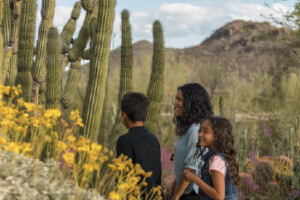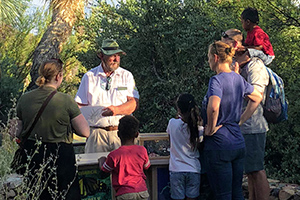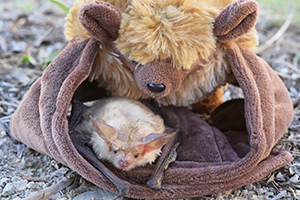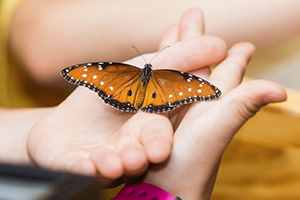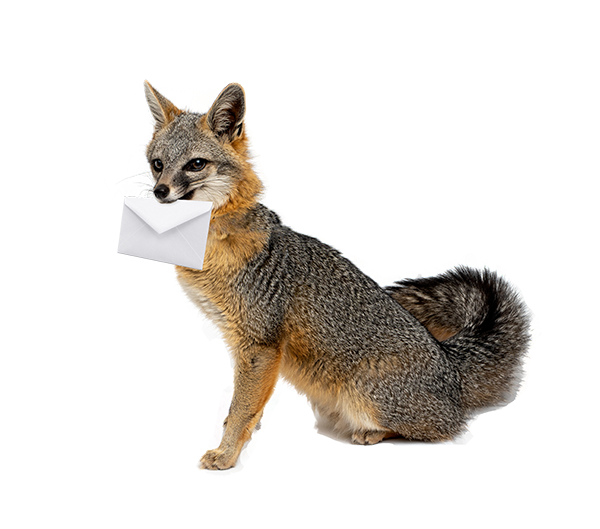Sonoran Desert Natural Events Calendar
Summer Monsoon
July, August, Early September
July
Average high: 98.4�F (36.9�C)
Average low: 73.6�F (23.1�C)
Relative humidity at 5 am: 57%
Relative humidity at 5 pm: 28%
Normal rainfall: 2.54� (64.5mm)
Summer rains arrive, bringing welcome relief from the hot and dry days of May and June. Locally we call them �monsoons,�which is a slight misnomer since the term refers to a seasonal shift in winds, bringing wet and dry periods to a region. Creeks run again, and a second springtime begins with the abundant rain.
Flora
Summer rains produce a second round of wildflowers, including summer poppies, devil�s claw, and morning glories, as well as blooms of woody plants, and also some of the agaves. Riparian canyons, especially those close to the Mexican border, are lush, hot, humid and full of life.
Fauna
Summer rains trigger a second breeding season for many animals, from insects to the birds and mammals that feed on the insects. Many butterflies emerge or arrive with the rains; look for monarchs, sulphurs, queens, fritillaries, and two-tailed swallowtails. Giant four-inch-long palo verde beetles, which as nymphs feed on the roots of their namesake host plants, emerge to mate and lay eggs. Amphibians such as the spadefoots, Sonoran green toads, and red-spotted toads begin their short and frenzied reproductive cycles in the shallow rain puddles throughout the region. The nectar-feeding bats and their new young begin to move south, following the blooms of agaves. Look for swirling swarms of winged leaf- cutter and harvester ants the morning after heavy rain; these are new queens and males which will mate and establish new colonies.
Nature Watching Tips for July
Evening drives or walks along backcountry roads will reveal an orgy of
amphibian and reptile activity in the hot and humid monsoon season. The
roads throughout Avra Valley west of Tucson are favorites among herpetophiles.
![]()
August
Average high: 96.2�F (35.7�C)
Average low: 72�F (22.2�C)
Relative humidity at 5 am: 65%
Relative humidity at 5 pm: 33%
Normal rainfall: 2.03� (51.6mm)
Summer rains continue throughout the month, with dramatic lightning and thunderstorms. Temperatures remain high, although they are a little less hot than in July. Mornings tend to be clear, while the storms build and break sometime after noon.
Flora
Prickly pear cactus fruit begins to ripen. Many birds, mammals and insects will feed on them. Blooms continue on plants such as barrel cacti, asters, four o�clocks, buffalo gourds and ground cherries. The little orange fruits of desert hackberry shrubs ripen this month; look for Empress Leilia hackberry butterflies in the foliage.
Fauna
Young regal horned lizards continue to hatch this month. Late- summer through fall bird migrations get underway, with species that spent the summer in the north arriving here for the winter or passing through on their way farther south. Hummingbirds such as rufous and Allen�s begin to migrate through, feeding on summer-season blossoms. In some years, snout butterflies become so numerous that they can clog automobile radiators on rural roads.
Nature Watching Tips for August
There is a dramatic increase in hummingbird activity this month, as many
species begin �tanking up�fat reserves for migration, and other species
arrive here on their way south; check out established feeders at mid-elevation
canyons such as Madera Canyon in the Santa Rita Mountains near Green Valley.
Call Coronado National Forest at (520) 281-2296. ![]()
September
Average high: 93.5�F (34.2�C)
Average low: 67.3�F (19.6�C)
Relative humidity at 5 am: 55%
Relative humidity at 5 pm: 27%
Normal rainfall: 1.34� (34.0mm)
Rains continue in the first few days of September, but by the end of the month it will seem like a repeat of May: dry and hot. Fall may begin to creep into mountain canyons and the higher elevations, as nighttime temperatures drop closer and closer to freezing.
Flora
Blooming continues in the deserts and desert grasslands; asters and sunflowers are especially lush. Also, look for the golden yellow blooms of snakeweed, turpentinebush, goldeneyes, and telegraph plants. Sticker and burr season begins as plants put out their seeds in ways that ensure good transportation away from the parents; canyon ragweed, with its almond-sized, fishhook-spined fruits, are a particularly noticeable fruiting plant for hikers. If rains were sufficient, a good crop of prickly pear cactus fruit should be very ripe. Bright pink piles of coyote scat on backroads and trails are dead giveaways to the omnivorous nature of those desert canines. Seep-willow shrubs bloom in washes and rocky canyon bottoms.
Fauna
Fall bird migrations reach their peak; ponds, such as golf course hazards or wastewater treatment plants, are excellent stopovers for waterfowl, and some will stay for the winter. Turkey vultures, Western kingbirds, and many species of hawks congregate as they prepare to move south. Desert bighorn sheep are breeding. Common butterflies include gray hairstreaks, funereal duskwings, and painted ladies.
Nature Watching Tips for September
If the summer rains were good and the corresponding blooms of milkweed
are abundant, large numbers of beautiful monarch butterflies may be seen
in low- to mid-elevation canyons. One good place for butterfly watching
is Brown Canyon, in the Baboquivari Mountains. Call the U.S. Fish and
Wildlife Service�s Buenos Aires National Wildlife Refuge at (520) 823-4251.
White Tanks on the northwest side of Phoenix is another very good place
to do some butterfly watching. ![]()

